Cover image of Ant-eating Chat by Desire Darling – Addo Elephant National Park, Eastern Cape – BirdPix No. 7088
Identification
The Ant-eating Chat is distinctive and easily recognisable. It has overall dark, dusky brown plumage with striking and distinctive white primaries when seen in flight. The body shape is somewhat dumpy and has an upright stance on fairly long legs.

Near Graafwater, Western Cape
Photo by Zenobia van Dyk
The sexes differ subtly as the male is slightly darker than the female. Males also have a white carpal patch on each shoulder, but these are frequently concealed when perched. Females lack the white shoulder patches.
Juveniles have a rufous wash to the dark brown plumage and show less white in the wings.
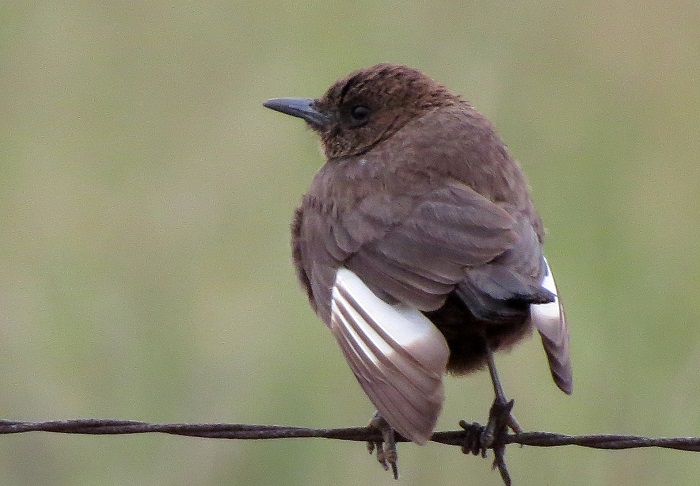
Middelburg, Eastern Cape
Photo by Tino Herselman
It is most easily mistaken for the female Mountain Chat Oenanthe monticola which is a little larger, with a longer, white-edged tail and a white rump.
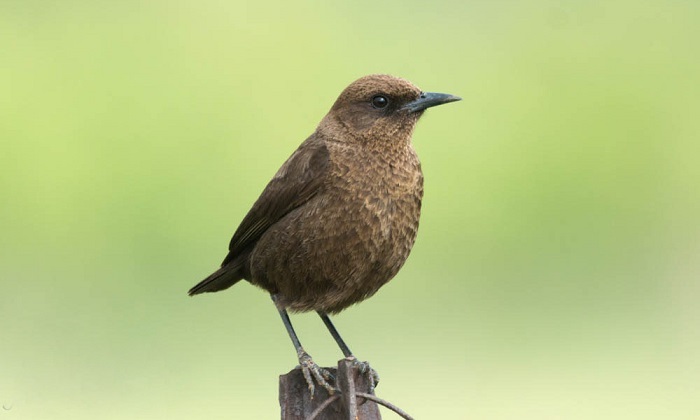
Schoemansdrift, North West
Photo by Jaco Botes
Status and Distribution
The Ant-eating Chat is a Southern African endemic. It is common and widespread in the central parts of the region. It is primarily an inland species and is mostly absent from coastal areas, except along the west coast of South Africa. The Ant-eating Chat is also absent from the most arid parts of Namibia and is currently not known to occur in Zimbabwe or Mozambique.
It is possible that the range of the Ant-eating Chat has increased in some parts of its range due to bush clearing for agriculture such as in the Western Cape near Cape Town, the western parts of Limpopo and the adjoining eastern region of Botswana. Conversely, the Ant-eating Chat appears to have suffered local extinctions in much of Lesotho and the former Transkei region of the Eastern Cape. This is due to intense human predation of small burrowing mammals, upon which the Ant-eating Chat relies for nest sites, as well as high livestock densities which appear to eliminate many ground-nesting birds.
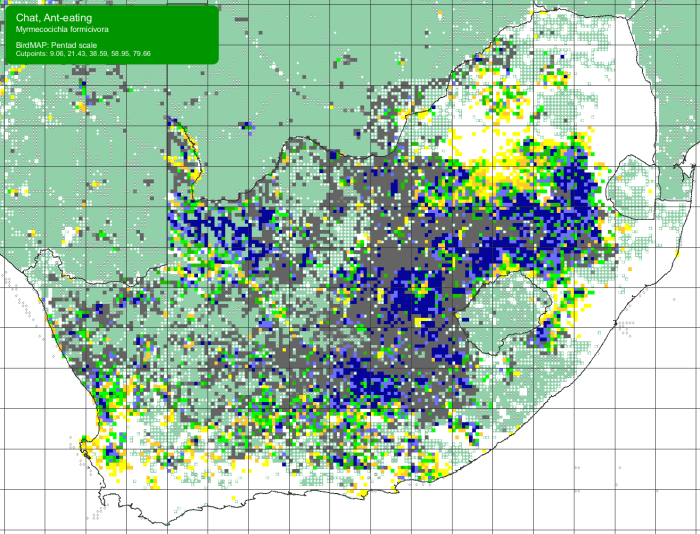
Details for map interpretation can be found here.
Habitat
The Ant-eating Chat occurs in open grassy habitats, usually with at least some scrub and bushes for perching on. It favours semi-arid Karoo shrublands, open grasslands, rolling grassy hills and open, arid Kalahari savanna on sands.

Photo by Ryan Tippett
Behaviour
The Ant-eating Chat is conspicuous and distinctive in its behaviour. It occurs singly, in pairs, or in small family groups of up to 6 or more birds. They are not territorial but occupy well-defined home ranges. Flies with rapidly beating wings, hovering, swerving and dropping to perch or to ground; often raises tail after landing. Roosts and nests in cavities in the ground.

Kgalagadi Transfrontier Park, Northern Cape
Photo by Johan and Estelle van Rooyen
Forages by hopping or running about on the ground, or by dropping onto prey from a perch. Primarily consumes ants and termites but also takes a range of other insects and arachnids, including grasshoppers, beetles and solifugids. They are also known to eat millipedes and berries in season.

Near Himeville, KwaZulu-Natal
Photo by Pamela Kleiman
The Ant-eating Chat has a prolonged spring and summer breeding season with a peak from October to December. In display the male flies with stiff wings, while tilting sideways to show the conspicuous white shoulders. Males sometimes also fly rapidly for 40-50 m before hovering for several seconds. All displays are accompanied by singing.
Nests are solitary and are widely spaced. Multiple broods per season are attempted and cooperative breeding frequently takes place whereby a pair and one or two juveniles from the previous brood act as helpers at the nest.
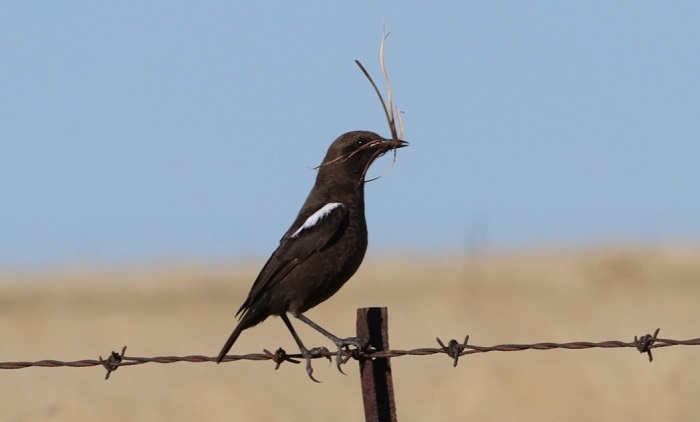
Vaalbank, Free State
Photo by Dawie de Swardt
The Ant-eating Chat mostly uses the holes of burrowing mammal species such as the Aardvark (Orycteropus afer), Porcupine (Hystrix africaeustralis), Springhare (Pedetes capensis), Ground Squirrel (Xerus inauris) and Yellow Mongoose (Cynictis pinicillata), inside of which they will excavate their own nest tunnel. Excavation of the tunnel and all nest building duties are shared by both sexes. The soil is loosened with the bill and shovelled out with the feet. The tunnel takes the birds around eight to ten days to complete and may be up to 1.5m deep. They will also utilise gullies, stream banks, road cuttings or sand quarries as nesting sites.
The nest is a bowl of dry grass and roots, placed in a chamber at end of the tunnel. From 2 to 7 plain whitish eggs are laid per clutch and incubation usually starts once all the eggs have been laid. The incubation period lasts for 14 or 15 days and all incubation is performed by the female. Hatchlings are fed by both adults and sometimes by up to 2 helpers from earlier broods. Fledged juveniles use the nest burrow for shelter, roosting, and as a bolt hole when alarmed. Brood parasitism by the Greater Honeyguide (Indicator indicator) has been recorded.
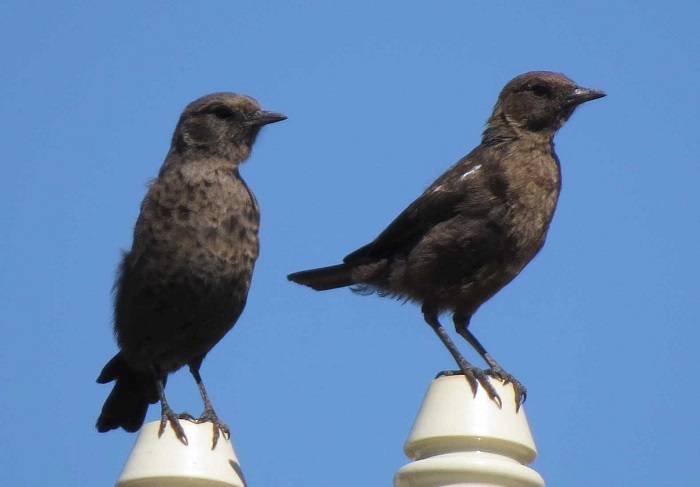
Near Venterstad, Eastern Cape
Photo by Tino Herselman
Further Resources
Species text adapted from the first Southern African Bird Atlas Project (SABAP1), 1997.
The use of photographs by Dawie de Swardt, Desire Darling, Jaco Botes, Johan and Estelle van Rooyen, Pamela Kleiman, Tino Herselman and Zenobia van Dyk is acknowledged.
Virtual Museum (BirdPix > Search VM > By Scientific or Common Name).
Other common names: Swartpiek (Afrikaans); Leping (Tswana); Isanzwili (Xhosa); Traquet fourmilier (French); Termitenschmätzer, Ameisenschmätzer (German); Kaapse Miertapuit (Dutch); Chasco-formigueiro-meridional (Portuguese)
Recommended citation format: Tippett RM 2023. Ant-Eating Chat Myrmecocichla formicivora. Biodiversity and Development Institute. Available online at http://thebdi.org/2023/05/29/ant-eating-chat-myrmecocichla-formicivora/
List of bird species in this format is available here.

